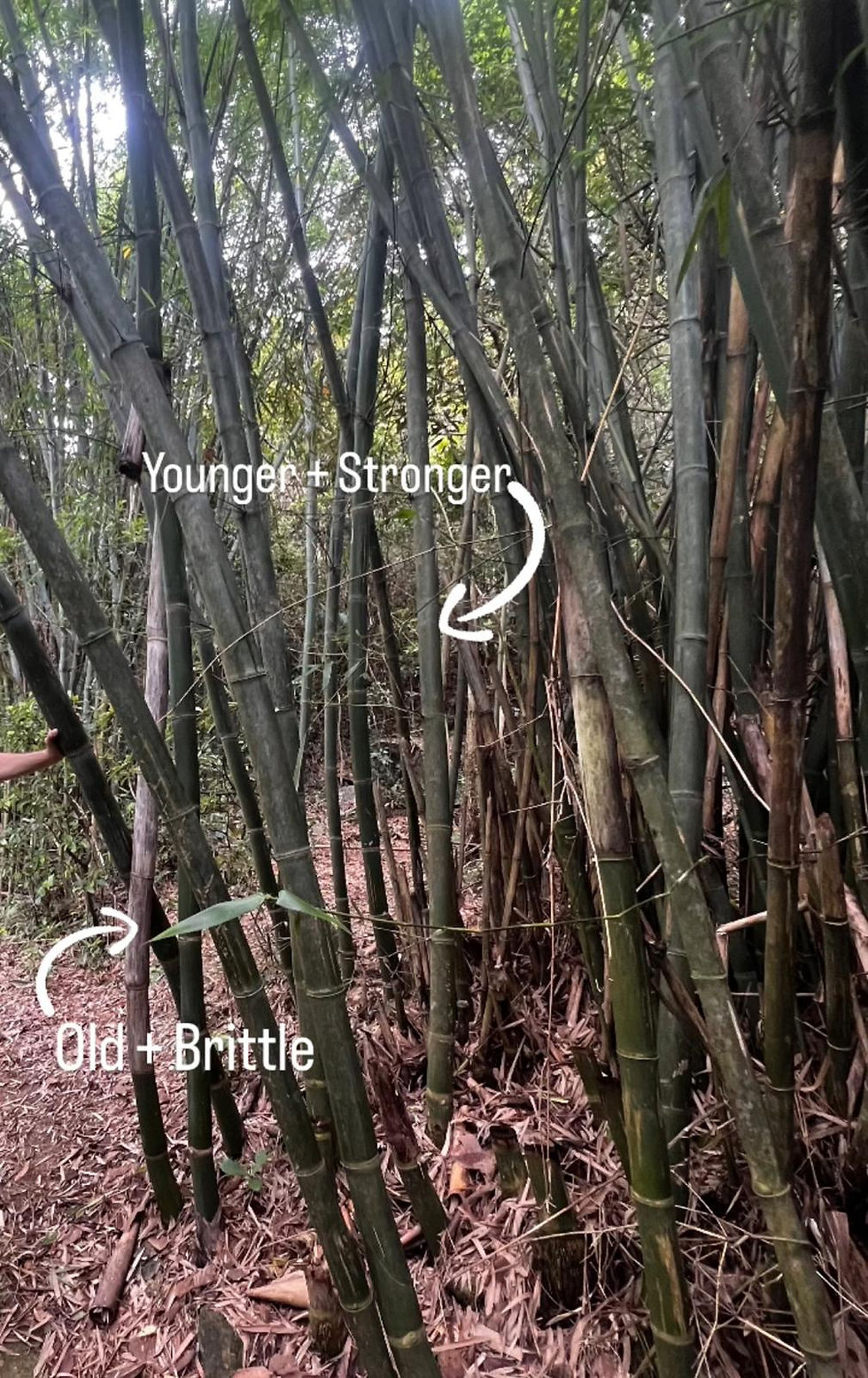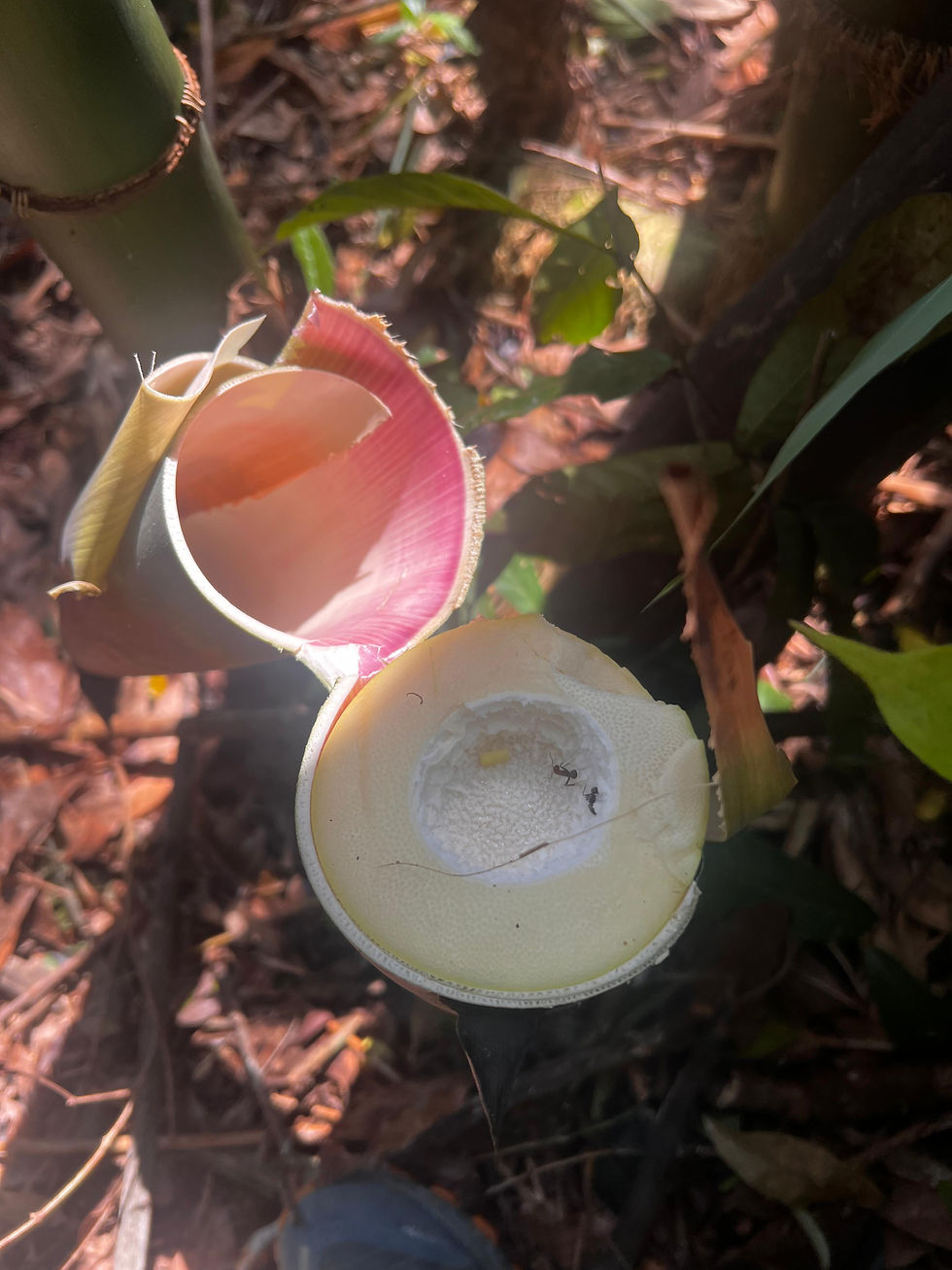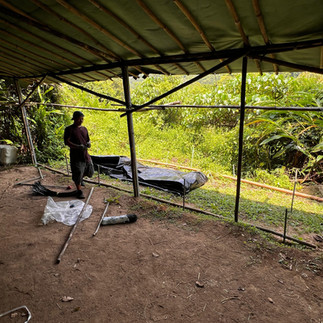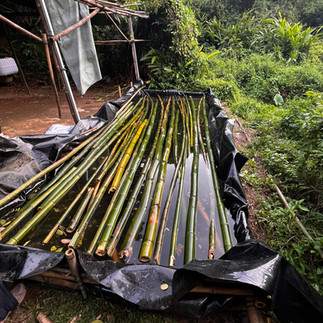Bamboo Secrets: Harvesting and Treating for Long-Lasting Builds
- Alexandra S-L

- Aug 25
- 5 min read
We’ve been busy harvesting bamboo from our site to create a roof that will shelter our earth walls during the workshops this November. Hong Kong’s climate can be harsh on natural materials — heavy rains, termites, and high humidity all take their toll. For bamboo structures to last, the culms need to be carefully harvested and treated.
In this post, we’ll take you through that process: why bamboo is such a brilliant sustainable building material, how and when to harvest it, and the traditional and modern ways of protecting it so it can last for years.

Why Bamboo?
Bamboo is one of nature’s most versatile building materials. It’s strong, lightweight, flexible, and grows incredibly quickly. In just a few months, a bamboo culm shoots to its full height and diameter — it never gets any wider no matter how long you leave it. Instead, as it ages, it changes from fresh green to a duller brown and gradually becomes more brittle and vulnerable to pests.

That’s where good harvesting practice comes in.
Sustainability in the Grove
Harvesting bamboo isn’t just about taking material for ourselves — it’s also essential for the health of the plant. Bamboo grows in clusters. If too many mature culms are left standing, the clump becomes overcrowded, damp, and shaded. This stresses the plant and can slow or weaken the next generation of shoots. By removing older culms, we open up space, light, and airflow, which encourages vigorous new growth.

Different Bamboos, Different Uses
There are hundreds of bamboo species, each with unique qualities. Some are thick and strong — perfect for structural frames. Others are slender and flexible, better suited for weaving or lashing.
Moso Bamboo – large, thick-walled, used for structural poles.
Guadua Bamboo – famously strong, widely used in Latin America for houses and bridges.
Dendrocalamus species – tall giants, often chosen for scaffolding.
Smaller local varieties – ideal for fences, trellises, and woven panels.
Choosing the right bamboo for the right job is part of the art.
Why Treat Bamboo?
Left untreated, bamboo in a humid climate might last just 2–3 years before pests and rot break it down. With proper treatment, that lifespan can extend to 10–15 years or more.
The main enemies are:
Insects (termites and beetles love the sugary starch inside bamboo).
Fungi and rot in damp conditions.

A close-up of why bamboo needs treating — ants love the sugary starch inside fresh bamboo. By soaking the culms in a borax and boric acid solution, the starch is replaced with minerals, making it unappealing to insects and giving the bamboo a much longer life.
Sustainable Treatment Methods
Running water – placing fresh bamboo in a stream to leach out sugars.
Pros: Natural, effective.
Cons: Needs a reliable stream and several weeks.
Heating – curing bamboo with fire or hot air.
Pros: Drives out moisture quickly.
Cons: Can cause cracks, doesn’t remove starch fully.
Charring – lightly burning the surface.
Pros: Creates a protective skin, water resistant.
Cons: Only surface-level, not effective against insects inside.
Boric acid/borax soak – replacing sugars with a safe mineral solution.
Pros: Non-toxic, long-lasting, effective against insects.
Cons: Requires a large container for soaking.
Painting/sealing – coating bamboo with oils, wax, or paints.
Pros: Helps prevent weathering.
Cons: Only protects the surface, not the inner fibers.
For our project, we chose the boric acid + borax solution. It’s safe to handle, sustainable, and highly effective — and unlike a stream, we don’t need continuous running water on-site.
Boric Acid + Borax
So what exactly are boric acid and borax?
Both are naturally occurring boron compounds found in the earth. Borax is a mineral salt, and boric acid is a weak acid of boron. When combined in water, they form a solution that penetrates bamboo and replaces the sugars with harmless boron salts. Insects can’t digest it, fungi don’t like it, and humans can handle it safely.
Another sustainable bonus: the same solution can be reused multiple times.
Step-by-Step Treatment
Mix boric acid and borax with water (1:1 ratio, about 10% solution).
Place freshly cut bamboo (within 48 hours of harvest) into the solution.
Leave submerged for 2–3 weeks.
Remove and dry in a shaded, airy spot for 1–2 months.
Preparing the Bath
To soak our bamboo, we built a treatment bath using old bamboo poles and a pool liner. The bamboo was lashed into a lattice frame, with the liner laid inside to form a waterproof basin. Cleverly, we bought the liner double the width, so we could fold it back over the bath like a lid. On one side, the liner was sandwiched between two poles to create a simple hinge, making it easy to open and close.
Why the lid? It keeps rainwater out — if the solution dilutes, it won’t work effectively.
As luck would have it, we saw a Typhoon 10 warning approaching. Probably the only people in Hong Kong celebrating the news, we rushed to finish the bath before the storm hit, knowing it would fill our pool for free. Myself, Dhan, and Angus worked together to get it ready — and the typhoon delivered!
Chopping the Bamboo
Once the storm passed, we set out to cut the bamboo. Timing is crucial: bamboo needs to go into the solution within 48 hours of being cut. After that, the sugars inside begin to ferment, attracting pests and making treatment less effective.
We carefully harvested culms from different clusters, never clearing a whole patch, so that the grove stays balanced and healthy for future growth.

One stump we cut revealed a vivid reminder of why treatment is essential: ants had already started eating into the sugary core. Once treated, those starches are replaced with boron salts, making the bamboo unappetising to insects.
Before soaking, we drilled small holes into each bamboo segment to allow the solution to reach every chamber.
Time to Soak
With the bamboo cut and prepared, it was time for treatment. We mixed the boric acid and borax into the rain-filled bath, walking barefoot in the cool water to stir it until dissolved. Safe, natural, and strangely fun.

Each bamboo pole was slid into the bath and weighed down, so it stayed fully submerged. Finally, we pulled the liner-lid over the top to keep out rainwater and left it to soak. Over the next two weeks, the solution will be drawn deep into the culms, replacing the sugars inside.
After soaking, the bamboo will dry slowly in the shade for two months, hardening and stabilising, ready to become the roof that will shelter our earth walls during the November workshops.
✨ This process is slow and careful, but it’s deeply rewarding. We’re not just using bamboo as a material — we’re working with it, respecting its cycles, and learning how to build in tune with nature. 🌍Next up: The kids start making bricks!
With muddy hands and full hearts,
Alex
Bisque-kit





























Comments